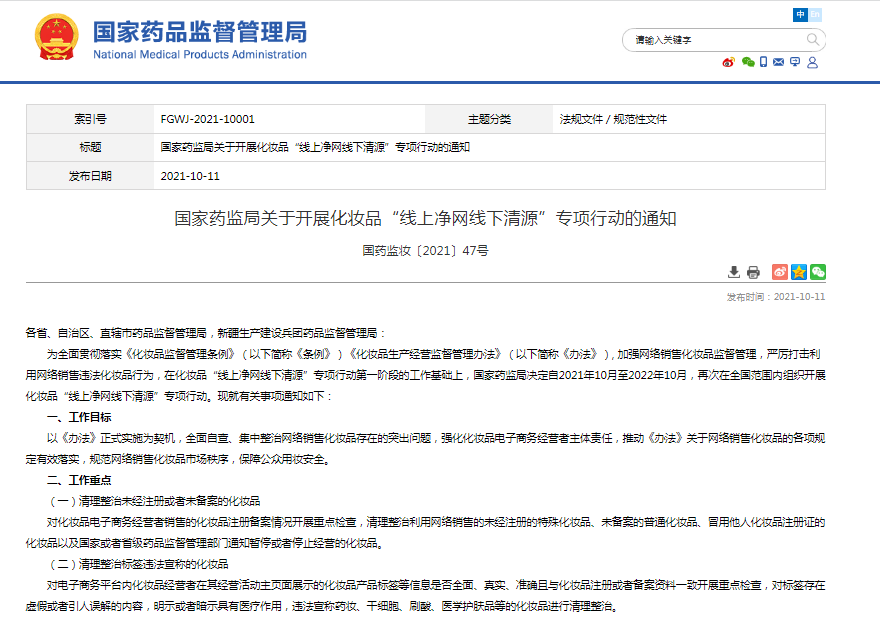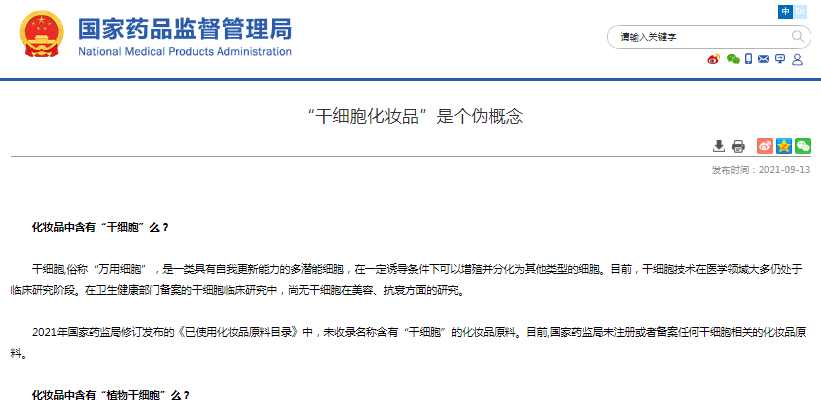XiaonishaAugust 05, 2025
Tag: cosmetics , stem cells , acid peeling
Recently, the new interpretation of "morning C, night A" has soared to the top of trending topics, which refers to the need for Coffee (caffeine) to stay alert during the day and Alcohol (alcoholic beverages) to aid sleep at night. In fact, "morning C, night A" has long been a popular skincare routine. Narrowly speaking, it means using cosmetics containing Vitamin C (VC) in the morning and cosmetics containing Vitamin A (VA) at night. Broadly speaking, it refers to choosing "antioxidant" skincare products for whitening during the day and "anti-aging" products for repair at night. VA refers to a class of compounds with retinol bioactivity, including retinol, retinol/yeast polypeptide, retinal, retinyl propionate, retinyl retinate, retinyl linoleate, retinyl acetate, and retinyl palmitate, as listed in the "Inventory of Ingredients Used in Cosmetics." These compounds function by converting into retinoic acid, but it is worth noting that retinoic acid, which is a banned ingredient in cosmetics due to its potential side effects such as skin irritation, redness, and even peeling during initial use.
On October 11, the National Medical Products Administration issued a "Notice on Carrying Out the Special Action of 'Purifying Online Cosmetics Sales and Rooting Out Offline Illegalities'." It announced that from October this year to October next year, a special action of "purifying online cosmetics sales and rooting out offline illegalities" will be organized and carried out nationwide once again. The focus of this special action mainly includes three aspects: first, cleaning up and rectifying cosmetics that have not been registered or filed; second, cleaning up and rectifying cosmetics with illegal labeling claims; third, cleaning up and rectifying cosmetics with quality and safety risks. Among the priorities of the work, it includes cleaning up and rectifying cosmetics that illegally claim to be medicated cosmetics, contain stem cells, involve acid peeling, or are medical skincare products.

Cosmeceuticals are referred to as COSMECEUTICAL in foreign countries, but in China, there is no definitive classification for cosmeceuticals. There are mainly three interpretations of the concept of cosmeceuticals: one is medicinal cosmetics, another is medical skincare products, and the third is functional cosmetics. The country has always been stringent in cracking down on cosmeceuticals, and they have been banned for a relatively long time. As early as 2010, the former National Food and Drug Administration Office pointed out in the "Notice on Strengthening the Daily Supervision of Cosmetics Labeling and Claims" that violations such as exaggerated promotion and the use of medical terminology in labeling and claiming "cosmeceuticals" or "medical skincare products" would be a key focus of routine supervision and inspection. In 2011, the "Notice on Further Strengthening the Supervision and Inspection of Illegal Labeling of Cosmetics" reiterated the importance of focusing on checking "whether there are illegal and irregularities behaviors such as exaggerated promotion in labeling and claiming 'cosmeceuticals' or 'medical skincare products' on small packages or instructions." On January 10, 2019, the Cosmetics Regulatory Department of the National Medical Products Administration issued the "Answers to Common Questions in Cosmetics Supervision and Management," once again clarifying that products registered or filed under the name of cosmetics that claim to be "cosmeceuticals," "medical skincare products," or other similar concepts, are all illegal. Under the strong supervision of the state, related "cosmeceuticals" on the market have almost disappeared.

On September 13, 2021, the National Medical Products Administration published a science popularization article titled "The Concept of 'Stem Cell Cosmetics' is Pseudoscience."
The article explains that stem cells are a type of multipotent cells with self-renewal capabilities, which can proliferate and differentiate into other types of cells under certain inducing conditions. Currently, stem cell technology is mostly still in the clinical research stage in the medical field. Among the stem cell clinical studies registered with health and health departments, there is no research on the use of stem cells in beauty or anti-aging.
The article states that in the "Inventory of Raw Materials Already Used in Cosmetics" revised and released by the National Medical Products Administration in 2021, some plant-derived cosmetic raw materials have been included. The addition of these plant-derived raw materials to cosmetics primarily functions through their plant-based chemical components, and there is no inevitable connection with whether they are meristematic tissues of plants. The "Inventory of Raw Materials Already Used in Cosmetics" revised and released by the National Medical Products Administration does not include any cosmetic raw materials whose names contain "stem cells," and the National Medical Products Administration has not registered or filed any cosmetic raw materials related to stem cells.
On August 11, 2021, the National Medical Products Administration published a science popularization article titled "Scientific Understanding of 'Acid Peeling' Beauty," which explained various aspects of "acid peeling," including its definition, potential adverse reactions, the limited amount of acid allowed in cosmetics, and claims made about it.
The article introduces that "so-called 'acid peeling' is actually a type of chemical peeling, also known as chemical exfoliation, which involves applying chemical agents to the skin surface to cause controlled damage, thereby promoting the regeneration of new skin." The type of chemical agent, its concentration, and the duration of its stay on the skin can all affect the depth of peeling. Depending on the depth of the chemical peeling effect, it can be classified into superficial peeling, medium peeling, and deep peeling. The deeper the peeling effect, the more pronounced the results, but also the higher the risk of adverse reactions.
The article provides a detailed introduction to the potential adverse reactions associated with "acid peeling," reminding consumers that "chemical agents at higher concentrations can have a certain degree of irritation and damaging effects on the skin. During the treatment process, temporary discomforts such as erythema, swelling, stinging, and burning sensations may occur. After the procedure, scabbing, pigmentation, and even a series of side effects such as burns, erosions, exudates, abnormal pigmentation, reactive acne, milia, telangiectasia, contact urticaria, and scarring may occur."
The article also clearly states that "the 'acids' used in 'acid peeling treatments' are not cosmetics." "Acid peeling treatments" must be performed by trained professionals in hospitals or clinics with medical qualifications. The "acids" used in these treatments are not cosmetics, and it is emphasized that acids such as Vitamin A acid and trichloroacetic acid cannot be used in cosmetics. The addition of certain "acids" to cosmetics is subject to strict usage restrictions and technical requirements, and the allowed concentrations are relatively low. For example, the content of alpha-hydroxy acids and their salts and esters (including malic acid, citric acid, and other fruit acids) in cosmetics must not exceed 6.0%, the pH value of the product must not be lower than 3.5, and in certain cases, it must be indicated on the label that "use with sunscreen cosmetics." The content of salicylic acid in cosmetics must not exceed 3.0%, and except for shampoos, it must not be used in products for children under three years old, and it must be labeled "contains salicylic acid, do not use for children under three years old."
With social progress, the development of science and technology, and the improvement of living standards, cosmetics are no longer a luxury for a few but have become an indispensable part of people's daily lives. While the cosmetics industry has developed rapidly, there have also been numerous reports of adverse reactions to cosmetics in recent years, and concerns about the safety of cosmetics have garnered widespread attention. To ensure the quality and safety of cosmetics and protect consumer health, the state has introduced a series of regulations and policies. Through research on these regulations and policies, supervision and management of cosmetic raw materials, production and operation, e-commerce platforms, and other aspects have been strengthened, and the regulatory system has been improved. For instance, the "Regulations on the Supervision and Administration of Cosmetics" was released in June 2020, and in July 2021, China's first departmental regulation specifically targeting the supervision and administration of cosmetic production and operation, the "Measures for the Supervision and Administration of Cosmetic Production and Operation," was issued. Additionally, the National Medical Products Administration (NMPA) has recently released the "Regulations on the Supervision and Administration of Children's Cosmetics." Furthermore, the NMPA has issued the "Guidelines for the Evaluation of Cosmetic Efficacy Claims" and revised the "Inventory of Raw Materials Already Used in Cosmetics (2015 Edition)" to create the "Inventory of Raw Materials Already Used in Cosmetics (2021 Edition)."
[1] Notice of the National Medical Products Administration on Carrying Out the Special Action of "Cleaning Up the Online and Offline Sources of Cosmetics"
https://www.nmpa.gov.cn/xxgk/fgwj/gzwj/gzwjhzhp/20211011154705160.html
[2] Pharmaceutical Cosmetics - Baidu Baike
[3] "Stem Cell Cosmetics" is a Pseudoconcept
https://www.nmpa.gov.cn/xxgk/kpzhsh/kpzhshhzhp/20210913164840136.html
[4] Scientific Understanding of "Acid Peeling" for Beauty
https://www.nmpa.gov.cn/xxgk/kpzhsh/kpzhshhzhp/20210811090320126.html
Xiaonisha, a food technology professional holding a Master's degree in Food Science, is currently employed at a prominent domestic pharmaceutical research and development company. Her primary focus lies in the development and research of nutritional foods, where she contributes her expertise and passion to create innovative products.


Contact Us
Tel: (+86) 400 610 1188
WhatsApp/Telegram/Wechat: +86 13621645194
+86 15021993094
Follow Us:




 Pharma Sources Insight July 2025
Pharma Sources Insight July 2025


